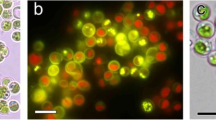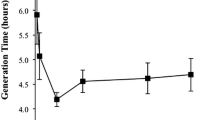Abstract
The accumulation and utilization of reserve phosphate in the extremely halophilic archaeon Halobacterium salinarium were studied. The growth of H. salinarium was found to depend on the initial concentration of inorganic phosphate (Pi) in the culture medium and its content in the inoculum. Growing cells consumed 85–95% of Pi from the medium. Unlike the reserve phosphates of many other microorganisms, which are mainly polyphosphates, the reserve phosphates of H. salinarium cells contain no more than 15% polyphosphates, the rest being magnesium orthophosphate. The excessive consumption of Pi from the medium led to a change in cell morphology and caused the death of part of the cell population. The cells that remained viable could grow in a Pi-deficient medium, utilizing about 70% of the reserve magnesium phosphate as the phosphorus source.
Similar content being viewed by others
REFERENCES
Kulaev, I.S., Biochemistry of Inorganic Polyphosphates, Chichester: Wiley, 1979.
Okorokov, L.A., Kholodenko, V.P., and Kulaev, I.S., Polymeric Iron Orthophosphate in Actinomycetes, Izv. Akad. Nauk SSSR, Ser. Biol., 1973, vol. 5, pp. 748–751.
Okorokov, L.A., Kholodenko, V.P., and Kulaev, I.S., New Compound, Polymeric Iron Orthophosphate, in Various Fungi, Dokl. Akad. Nauk SSSR, 1971, vol. 199, no. 5, pp. 1204–1205.
Kokoeva, M.V., Lobyreva, L.B., and Plakunov, V.K., The Physiological Significance of Transport Systems for Tyrosine in Halobacterium salinarium, Mikrobiologiya, 1992, vol. 61, pp. 945–949.
Andreeva, N.A., Kulakovskaya, T.V., and Kulaev, I.S., Inorganic Polyphosphates and Phosphohydrolases in Halobacterium salinarium, Mikrobiologiya, 2000, vol. 69, no. 4, pp. 499–505.
Reynolds, E.S., The Use of Lead Citrate at High pH as an Electron-Opaque Stain in Electron Microscopy, J. Cell Biol., 1963, vol. 17, pp. 208–213.
Smirnov, A.V., Kulakovskaya, T.V., and Kulaev, I.S., Phosphate Accumulation by an Extremely Halophilic Archaeon Halobacterium salinarium, Proc. Biochem., 2002, vol. 37, pp. 643–649.
Kulaev, I.S. and Vagabov, V.M., Polyphosphate Metabolism in Microorganisms, Adv. Microbiol. Physiol., 1983, vol. 24, pp. 83–171.
Zaitseva, G.N., Belozerskii, A.N., and Novozhilova, L.P., Phosphorus Compounds in Azotobacter vinelandii in the Process of Culture Growth, Biokhimiya, 1959, vol. 24, pp. 1054–1065.
Andreeva, N.A. and Okorokov, L.A., Purification and Characterization of Highly Active and Stable Polyphosphatase from Saccharomyces cerevisiae Cell Envelope, Yeast, 1993, vol. 9, pp. 127–139.
Bensadoun, A. and Weinstein, D., Assay of Proteins in the Presence of Interfering Materials, Anal. Biochem., 1976, vol. 70, pp. 241–250.
Bagabov, V.M., Trilisenko, L.V., and Kulaev, I.S., The Dependence of the Inorganic Polyphosphate Chain Length on the Orthophosphate Content in the Culture Medium of the Yeast Saccharomyces cerevisiae, Biokhimiya, 2000, vol. 65, no. 3, pp. 414–420.
Ohtake, H., Yamada, K., Hardoyo, S., Muramatsu, A., Anbe, Y., Kato, K., and Shinjo, H., Genetic Approach to Enhanced Biological Phosphorus Removal, Wat. Sci. Techn., 1994, vol. 30, pp. 185–192.
Kortstee, G.J.J., Appeldoorn, K.J., Bonting, C.F.C., van Niel, E.W.J., and van Veen, H.J., Recent Developments in the Biochemistry and Ecology of Enhanced Biological Phosphorus Removal, Biokhimiya, 2000, vol. 65, 3, pp. 394–404.
Keasling, J.D., Regulation of Intracellular Toxic Metals and Other Cations by Hydrolysis of Polyphosphate, Ann. New York Acad. Sci., 1997, vol. 829, pp. 243–249.
Madigan, M.M., Parker, J., Madigan, M.T., and Martinko, J.M., Brock Biology of Microorganisms, Upper Saddle River, New Jersey: Simon and Schuster, 1997.
Keasling, J.D., van Dien, S.J., Trelstad, P., Renninger, N., and McMahon, K., Application of Polyphosphate Metabolism to Environmental and Biotechnological Problems, Biokhimiya, 2000, vol. 65, no. 3, pp. 385–394.
Mino, T., Microbial Selection of Polyphosphate Accumulating Bacteria in Activated Sludge Wastewater Treatment Process for Enhanced Biological Phosphate Removal, Biokhimiya, 2000, vol. 65, no. 3, pp. 405–413.
Author information
Authors and Affiliations
Rights and permissions
About this article
Cite this article
Smirnov, A.V., Suzina, N.E., Kulakovskaya, T.V. et al. Magnesium Orthophosphate, a New Form of Reserve Phosphate in the Halophilic Archaeon Halobacterium salinarium. Microbiology 71, 677–683 (2002). https://doi.org/10.1023/A:1021479823000
Issue Date:
DOI: https://doi.org/10.1023/A:1021479823000




